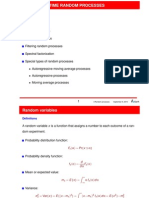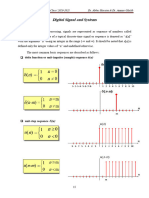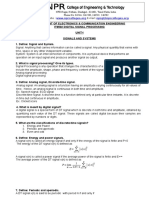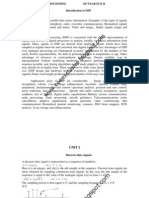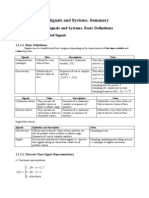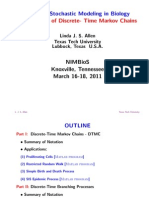BME I5100 Biomedical Signal Processing: Lucas C. Parra Biomedical Engineering Department City College of New York
BME I5100 Biomedical Signal Processing: Lucas C. Parra Biomedical Engineering Department City College of New York
Uploaded by
parrexCopyright:
Available Formats
BME I5100 Biomedical Signal Processing: Lucas C. Parra Biomedical Engineering Department City College of New York
BME I5100 Biomedical Signal Processing: Lucas C. Parra Biomedical Engineering Department City College of New York
Uploaded by
parrexOriginal Title
Copyright
Available Formats
Share this document
Did you find this document useful?
Is this content inappropriate?
Copyright:
Available Formats
BME I5100 Biomedical Signal Processing: Lucas C. Parra Biomedical Engineering Department City College of New York
BME I5100 Biomedical Signal Processing: Lucas C. Parra Biomedical Engineering Department City College of New York
Uploaded by
parrexCopyright:
Available Formats
1
Lucas Parra, CCNY
Cit y College of New Yor k
BME I5100: Biomedical Signal Processing
Stochastic Processes
https://blackboard-doorway.cuny.edu/
parra@ccny.cuny.edu
Some links from previous course: http://newton.bme.columbia.edu/~lparra/class/
Lucas C. Parra
Biomedical Engineering Department
City College of New York
CCNY
2
Lucas Parra, CCNY
Cit y College of New Yor k
Schedule
Week 1: Introduction
Linear, stationary, normal - the stuff biology is not made of.
Week 1-5: Linear systems
Impulse response
Moving Average and Auto Regressive filters
Convolution
Discrete Fourier transform and z-transform
Sampling
Week 6-7: Analog signal processing
Operational amplifier
Analog filtering
Week 8-11: Random variables and stochastic processes
Random variables
Moments and Cumulants
Multivariate distributions, Principal Components
Stochastic processes, linear prediction, AR modeling
Week 12-14: Examples of biomedical signal processing
Harmonic analysis - estimation circadian rhythm and speech
Linear discrimination - detection of evoked responses in EEG/MEG
Hidden Markov Models and Kalman Filter- identification and filtering
3
Lucas Parra, CCNY
Cit y College of New Yor k
A stochastic process is a random quantity that changes over
time. More specifically it is a set of random variables sorted
in time X[t]. Sampling a random process repeatedly gives and
ensemble:
Examples: Spike train, position of a particle moving randomly,
number of bacteria in a culture, thermal noise in an amplifier,
etc.
Stochastic Processes
e
1
e
3
e
2
S
x
1
[t]
x
2
[t]
x
3
[t]
4
Lucas Parra, CCNY
Cit y College of New Yor k
Stochastic Process - Poisson Process
Pr ( N (t +At )N (t )=1)=+At
Pr ( N (t )=k )=
(+t )
k
e
+t
k !
Pr ( N (t )=0)=e
+t
Poisson process arises when we count the number of occurrences
N(t) of independent random events where the likelihood of
occurrence of an event is proportional to the time interval t.
One can proof by induction that the count follows a Poisson
distribution with =t
Interesting is the first induction step. For k=0 using definition and
limes t 0 it is easy to see that
Which means that the ISI is exponentially distributed.
5
Lucas Parra, CCNY
Cit y College of New Yor k
Stochastic Process - Shot Noise
X (t )=
i=1
N
h(t )6(t t
i
)=
i=1
N
h(t t
i
)
Shot noise we call Poisson process with events at times t
i
convolved with a IR.
The expected value of X(t) is
Event or spike rate can be estimated by convolving a spike train
with a sufficiently long IR. This in effect is what neurons do,
where the IR is given by the post-synaptic potential (PSP).
Sometimes (t
i
-t
i-1
)
-1
is considered "instantaneous" spike rate (t).
E| X (t )=+(t )
h(u) du
6
Lucas Parra, CCNY
Cit y College of New Yor k
A stochastic process x(t) is said to be a Gaussian process if
x=[x(t
1
),x(t
2
),...,x(t
n
)]
T
are jointly Gaussian distributed
In general the covariance matrix and mean depend on the
time instances t
1
, t
2
, ... , t
n
.
Classic example is Brownian motion with
Stochastic Process - Gaussian Process
p( x)=
1
.
(2n)
n
2
exp
|
1
2
( xj)
T
2
1
( xj)
r
ij
=Bmin(t
i
, t
j
)
7
Lucas Parra, CCNY
Cit y College of New Yor k
If p(x(t
1
),x(t
2
),...,x(t
n
)) does not depend on times t
1
, t
2
, ... , t
n
the
process is called stationary.
Any stochastic process for which the mean and covariance are
independent of time is called Wide Sense Stationary (WSS).
A WSS process is called ergodic if the sample average
converges to the ensemble average. With samples x[k] = x(t
k
)
this reads:
Stochastic Process - Wide Sense Stationary
E| f ( x(t ))=lim
N -
1
N
k=1
N
f ( x| k )
8
Lucas Parra, CCNY
Cit y College of New Yor k
If we have equal distant samples, x[k] = x(kT), the second
moments correspond to the auto-correlation
For WSS stochastic processes:
The mean is independent of time
The Auto-correlation
depends only on time differences
it is symmetric,
the zero lag is the power
upper bounded by the power
Stochastic Process -Auto-correlation
r
x
| k , l =E| x| k x
|l
r
x
| k , l =r
x
| kl
m
x
=E| x| k
r
x
| k =r
x
|k
r
x
|0r
x
| k
r
x
|0=E|x| k
2
r
x
| k =E| x| n+k x
| n
9
Lucas Parra, CCNY
Cit y College of New Yor k
Assuming ergodic WSS a direct estimate of the auto-
correlation is the (unbiased) sample auto-correlation
Note that correlation is convolution with opposite sign. It can
be computed fast with the FFT. Use xcorr()
Stochastic Process - Auto-correlation
r
x
| k =
1
Nk
l =1
Nk
x|l +k x
|l
x*
x
k N
10
Lucas Parra, CCNY
Cit y College of New Yor k
Examples
Stochastic Process - Auto-correlation
11
Lucas Parra, CCNY
Cit y College of New Yor k
For WSS the auto-correlation matrix becomes Hermitian
Toeplitz
Important WSS process is (Gaussian) uncorrelated noise
>> randn()
Stochastic Process -Auto-correlation
R
xx
=
|
r
x
(0) r
x
(1) r
x
(2) r
x
( p)
r
x
(1) r
x
(0) r
x
(1) r
x
( p1)
r
x
(2) r
x
(1) r
x
(0) r
x
( p2)
r
x
( p) r
x
( p+1) r
x
( p+2) r
x
(0)
R
xx
=c
2
I m
x
=0
12
Lucas Parra, CCNY
Cit y College of New Yor k
Oscillations of the correlation are best analyzed in the
frequency domain, which leads to the Power Spectrum
One can show that P
x
(e
j
) is real, even and positive.
The auto-correlation can be recovered with the inverse
Fourier transform
Stochastic Process - Power spectrum
P
x
(e
j o
)=
k=
r
x
| k e
jk o
r
x
| k =
1
2n
n
n
d oP
x
(e
j o
)e
jk o
13
Lucas Parra, CCNY
Cit y College of New Yor k
In particular, the total power is given by
the power spectrum is sometimes called spectral density
because it is positive and the signal power can always be
normalized to r(0) =(2)
-1
.
Example: Uncorrelated noise has a constant power spectrum
Hence it is also called white noise.
Stochastic Process - Power spectrum
r | k =E| x| n+k x
| n=c
2
6( k )
P
x
(e
j o
)=
k=
c
2
6( k ) e
jk o
=c
2
r
x
|0=E|x| k
2
=
1
2n
n
n
d oP
x
(e
j o
)
14
Lucas Parra, CCNY
Cit y College of New Yor k
The power spectrum captures the spectral content of the
random sequence. It can be estimate directly from the Fourier
transform of the data:
This estimate improves in the mean with increasing N.
Remember that when estimating auto-correlation and power
spectrum we implicitly assume WSS processes!
Stochastic Process - Power spectrum
P
x
(e
j o
)=
1
N
X (e
j o
)
2
X (e
j o
)=
k=0
N1
x| k e
j ok
P
x
(e
j o
)=lim
N -
E|
P
x
(e
j o
)
15
Lucas Parra, CCNY
Cit y College of New Yor k
Unfortunately, the direct estimate is inconsistent, i.e. its
variance does not converge to 0 for increasing N.
A classic heuristic, called the periodogram, is to smooth
neighboring frequencies: Compute Fourier transform for
window of size N/K and average over K windows.
Stochastic Process - Power spectrum
16
Lucas Parra, CCNY
Cit y College of New Yor k
Examples: >> psd(x);
Note 1/f spectrum, noise for small N.
Stochastic Process - Periodogram
17
Lucas Parra, CCNY
Cit y College of New Yor k
The effect of filtering on the statistics of a stochastic process:
Filtering corresponds to convolution of the autocorrelation
Stochastic Process - Filtering
y| n=
k=
h| k x| nk
r
y
| k =
l =
m=
h|l r
x
| ml +k h
(m)
=r
x
| k h| k h
|k
y[n]
x[n]
h[k]
r
x
[n]
h[k]
h
*
[-k]
r
y
[n]
r
yx
[k]
18
Lucas Parra, CCNY
Cit y College of New Yor k
With the convolution theorem of the Fourier transform we find
for the power spectrum
Or in the z-domain
Stochastic Process - Filtering
P
y
(e
j o
)=P
x
(e
j o
) H (e
j o
) H
(e
j o
)=P
x
(e
j o
)H (e
j o
)
2
P
yx
(e
j
)
H(e
j
) H
*
(e
j
)
P
y
(e
j
)
P
x
(e
j
)
|H(e
j
)|
2
P
x
(e
j
) P
x
(e
j
)
|H(e
j
)|
2
P
y
( z)=P
x
( z) H ( z) H
(1/ z
)
19
Lucas Parra, CCNY
Cit y College of New Yor k
Filtering shapes the power spectrum
Stochastic Process - Filtering
abs(fft(h,N)).^2
20
Lucas Parra, CCNY
Cit y College of New Yor k
"The power spectrum gives the spectral content of the data."
To see that consider the power of a signal after filtering with a
narrow bandpass filter around
0
.
Stochastic Process - Spectral Content
E|y| n
2
=
1
2n
n
n
d oH (e
j o
)
2
P
x
(e
j o
)
=
1
2n
o
0
Ao/ 2
o
0
+Ao/ 2
d oP
x
(e
j o
)
Ao
2n
P
x
(e
j o
0
)
0
H(e
j
)
21
Lucas Parra, CCNY
Cit y College of New Yor k
Colored noise process x[n] is filtered white noise v[n]
If h[n] is causal and invertible, x[n] is called a regular process
and v[n] the corresponding innovation process with power
v
2
.
Its power spectrum is continuous and given by
The inverse filter 1/H(z) is called the whitening filter of x[n].
Stochastic Process - Regular process
x[n]
v[n]
h[n]
P
x
(e
j
)=
v
2
|H(e
j
)|
2
P
v
(e
j
) =
v
2
|H(e
j
)|
2
v[n] x[n]
1/H(z)
P
x
(e
j o
)=c
v
2
H (e
j o
)
2
22
Lucas Parra, CCNY
Cit y College of New Yor k
A process x[n] is called predictive or singular if it can be
predicted exactly from a linear combination of its past:
Examples are sinusoids or sums thereof:
The spectrum of a predictive process has only discrete lines:
Stochastic Process - Predictive process
x| n=
k=1
a| k x| nk
P
x
(e
j o
)=
k=1
o
k
6(oo
k
)
x| n=
k=1
A
k
e
i no
k
+
k
23
Lucas Parra, CCNY
Cit y College of New Yor k
The Wold decomposition theorem tells us that any WSS
process x[n] can be decomposed into a sum of a regular
process x
r
[n] and predictive process x
p
[n]:
where the processes are orthogonal:
Hence the spectrum of any WSS is composed of a continuous
component with invertible H(z) plus discrete lines:
Stochastic Process - Wold decomposition
x| n=x
p
| n+x
r
| n
E| x
p
| n x
r
| m=0
P
x
(e
j o
)=H (e
j o
)
2
+
k=1
o
k
6(oo
k
)
24
Lucas Parra, CCNY
Cit y College of New Yor k
Note that for orthogonal processes the power spectrum is
additive.
If
with
Then
Stochastic Process - Wold decomposition
z | n=x| n+y| n
E| x| n y
| m=0
P
z
(e
j o
)=P
x
(e
j o
)+P
y
(e
j o
)
25
Lucas Parra, CCNY
Cit y College of New Yor k
Spectrogram: Power spectrum with strong spectral
component can be estimate on short sequences, and hence,
followed as it develops over time.
Example: Speech >> specgram(x);
Assumption: WSS within each small window
Stochastic Process -Spectrogram
Note harmonic
components
26
Lucas Parra, CCNY
Cit y College of New Yor k
An important regular process is the ARMA process: white
noise v[n] filtered with a rational transfer function
Example:
Stochastic Process - ARMA process
H ( z)=
B( z)
A( z)
x[n]
a[k]
v[n]
h[k]
b[k]
H ( z)=
1+0.9025 z
2
10.5562 z
1
+0.81 z
2
27
Lucas Parra, CCNY
Cit y College of New Yor k
ARMA modeling means to find a[k], and b[k] that approximate
an observed P
x
(e
j
) for a given x[n]
Note that now the input is not given. Instead only statistical
assumptions on the input are know (white WSS process).
Stochastic Process - ARMA modeling
x[n]
a[k]
v[n]
h[k]
b[k]
P
x
(e
j o
)=
B(e
j o
)
2
A(e
j o
)
2
x| n=
l =1
P
a|l x| nl +
l =0
Q
b|l v| nl
28
Lucas Parra, CCNY
Cit y College of New Yor k
We derive now statistical conditions for a[k] and b[k]. Multiply
the difference equation by x
*
[n -k] and take the expectation:
with cross-correlation:
Using
we obtain (non-linear) conditions for a[k] and b[k]
Stochastic Process - ARMA modeling
l =0
P
a|l r
x
| kl =
l =0
Q
b|l r
vx
| kl
r
vx
| kl =E| v| nl x
| nk
x| n=h| nv| n
E| v| n v
| m=6(nm)
l =0
P
a|l r
x
| kl =
l =0
Q
b|l h
|l k
29
Lucas Parra, CCNY
Cit y College of New Yor k
These conditions are called the Yule-Walker equations
In matrix form and using Hermitian symmetry of the auto-
correlation we can write for lags 0...L:
Since c[k] depend on h[k] these equations are non-linear in a[k]
and b[k]. They simplify for Q=0, i.e. AR model only.
Stochastic Process - ARMA modeling
l =0
P
a|l r
x
| kl =
l =0
Qk
b|l +k h
|l c| k
|
r
x
|0 r
x
|1 r
x
| 2 r
x
| P
r
x
|1 r
x
|0 r
x
|1 r
x
| P1
r
x
|Q r
x
|Q1 r
x
|Q2 r
x
|QP
r
x
|Q+1 r
x
|Q r
x
|Q1 r
x
|QP+1
r
x
| L r
x
| L1 r
x
| L2 r
x
| LP
|
1
a|1
a| 2
a| P
=
|
c|0
c|1
c|Q
0
0
30
Lucas Parra, CCNY
Cit y College of New Yor k
For Q=0 the Yule-Walker equations simplify to
In matrix form and using Hermitian symmetry of the auto-
correlation we obtain the AR normal equations:
Which are a set of linear equations for the unknown a[k].
Stochastic Process - AR modeling
l =0
P
a|l r
x
| kl =b|0
2
6(k )
|
r
x
|0 r
x
|1 r
x
| 2 r
x
| P
r
x
|1 r
x
|0 r
x
|1 r
x
| P1
r
x
| 2 r
x
|1 r
x
|0 r
x
| P2
r
x
| P r
x
| P1 r
x
| P2 r
x
|0
|
1
a|1
a| 2
a| P
=
|
b|0
2
0
0
0
31
Lucas Parra, CCNY
Cit y College of New Yor k
The AR normal equations can be rewritten as:
Linear equations with Toeplitz Hermitian form can be solved
efficiently with the Levinson-Durbin recursion.
Computes the auto-correlations and solves this linear equation:
>> a = lpc(x,P);
Stochastic Process - AR modeling
|
r
x
|0 r
x
|1 r
x
| P1
r
x
|1 r
x
|0 r
x
| P2
r
x
| P1 r
x
| P2 r
x
|0
|
a|1
a| 2
a| P
=
|
r
x
|1
r
x
| 2
r
x
| P
R
xx
a=r
x
32
Lucas Parra, CCNY
Cit y College of New Yor k
The goal of linear prediction is to predict sample x[n] from its
past P samples:
And a[k] are called the linear prediction coefficients (LPC).
The prediction error is given by
The LPC that minimize the expected error
satisfy the same linear equations as the AR model parameters:
which we obtain by taking derivatives with respect to a
*
[k].
Stochastic Process - Linear prediction
e| n=x| n x| n
a=argmin E|e| n
2
l =0
P
a|l r
x
| kl =c6(k )
x| n=
k=1
P
a| k x| nk
33
Lucas Parra, CCNY
Cit y College of New Yor k
In matlab all this is done with:
>> a = lpc(x,P);
The error process e[n] represents the "new" or "innovative"
part over the linear prediction, hence the name innovation
process.
One can show that the innovation in linear prediction is white
and uncorrelated to the prediction,
Stochastic Process - LPC and Wold Decomp.
E| e| n e
| m=6(nm)
E| e| n x
| m=0
34
Lucas Parra, CCNY
Cit y College of New Yor k
Assignment 9:
Pick either speech or heart rate
>> load hrs.mat; x=hrs;
>> [x,fs]=wavread('speech.wav');x=x(5501:6012);
Generate an AR model by solving normal equations.
Plot an estimated power spectrum together with the AR
model spectrum.
Show the innovation process and its power spectrum.
Compute the LPC coefficient using lpc(x,P)
Compare your AR results with LPC.
Show the linear prediction estimation error.
Compute the signal to noise ratio (SNR) of your LPC model:
Show SNR in dB as a function of model order P.
Stochastic Process - AR and LPC
SNR=
n
x| n
2
n
e| n
2
You might also like
- Course 09-2 - Discrete Time Random SignalsDocument40 pagesCourse 09-2 - Discrete Time Random SignalschilledkarthikNo ratings yet
- Autocorrelation LTI SystemDocument12 pagesAutocorrelation LTI Systemmadsud69No ratings yet
- Digital Signal ProcessingDocument22 pagesDigital Signal Processingtdhinakaran100% (1)
- Barlett MethodDocument15 pagesBarlett Methodking khanNo ratings yet
- HST.582J / 6.555J / 16.456J Biomedical Signal and Image ProcessingDocument25 pagesHST.582J / 6.555J / 16.456J Biomedical Signal and Image ProcessingSrinivas SaiNo ratings yet
- Lecture 9: Brief Summary of Digital Signal Processing.: 1.1 OperationsDocument15 pagesLecture 9: Brief Summary of Digital Signal Processing.: 1.1 OperationsAce SilvestreNo ratings yet
- DSP Qs 2marksDocument36 pagesDSP Qs 2marksanon_624151290No ratings yet
- Analysis and Processing of Random SignalsDocument71 pagesAnalysis and Processing of Random SignalsdileepanmeNo ratings yet
- Ni Two Marks - NewDocument37 pagesNi Two Marks - NewAnuishuya SugumaranNo ratings yet
- Sampling ProcessDocument24 pagesSampling ProcessMuhammad Salah ElgaboNo ratings yet
- Ensemble Average and Time AverageDocument31 pagesEnsemble Average and Time Averageilg1No ratings yet
- Unit 1Document69 pagesUnit 1SivaKumar AnandanNo ratings yet
- Spectral Estimation ModernDocument43 pagesSpectral Estimation ModernHayder MazinNo ratings yet
- 3 Random ProcessesDocument24 pages3 Random ProcessesSamson ImmanuelNo ratings yet
- DSP_Lec3Document7 pagesDSP_Lec3yaseen.kNo ratings yet
- Digital Signal Processing: 2 Marks & Question-AnswersDocument30 pagesDigital Signal Processing: 2 Marks & Question-AnswerssridharanchandranNo ratings yet
- XLSTH C7Document38 pagesXLSTH C7tranhoang230202No ratings yet
- Digital Signal Processing Important 2 Two Mark Question and Answer IT 1252Document14 pagesDigital Signal Processing Important 2 Two Mark Question and Answer IT 1252startedforfunNo ratings yet
- It1252 Digital Signal ProcessingDocument22 pagesIt1252 Digital Signal ProcessingainugiriNo ratings yet
- Unit I - Discrete Fourier Transform Part - ADocument10 pagesUnit I - Discrete Fourier Transform Part - AindhuNo ratings yet
- DTSSP QBDocument37 pagesDTSSP QBgeetha657595No ratings yet
- Ec 1361 - Digital Signal ProcessingDocument16 pagesEc 1361 - Digital Signal ProcessingEleazar PaclibarNo ratings yet
- 2 Marks - CseDocument20 pages2 Marks - CserdjeyanNo ratings yet
- EEE310 05 Random Processes II PDFDocument24 pagesEEE310 05 Random Processes II PDFSupipi HiyadmaNo ratings yet
- A Brief Introduction To Some Simple Stochastic Processes: Benjamin LindnerDocument28 pagesA Brief Introduction To Some Simple Stochastic Processes: Benjamin Lindnersahin04No ratings yet
- Digital Signal Processing Important Two Mark Questions With AnswersDocument15 pagesDigital Signal Processing Important Two Mark Questions With AnswerssaiNo ratings yet
- Whole Digital Communication PPT-libreDocument319 pagesWhole Digital Communication PPT-librePiyush GuptaNo ratings yet
- Rajalakshmi Engineering College, ThandalamDocument40 pagesRajalakshmi Engineering College, Thandalamaarthy1207vaishnavNo ratings yet
- 1.1. Discrete-Time Signals and Systems. Basic DefinitionsDocument11 pages1.1. Discrete-Time Signals and Systems. Basic DefinitionsNirmal Kumar PandeyNo ratings yet
- Spectrum AnalysisDocument35 pagesSpectrum AnalysisdogueylerNo ratings yet
- Quantum PhysicsDocument17 pagesQuantum PhysicsAgnivesh SharmaNo ratings yet
- Phase Retrieval From Coded Diffraction Patterns: Emmanuel J. Cand' Es Xiaodong Li Mahdi Soltanolkotabi November 7, 2013Document23 pagesPhase Retrieval From Coded Diffraction Patterns: Emmanuel J. Cand' Es Xiaodong Li Mahdi Soltanolkotabi November 7, 2013jennyjhlee0621No ratings yet
- Ee8591 DSPDocument28 pagesEe8591 DSPtamizh kaviNo ratings yet
- DSP SlidesDocument100 pagesDSP SlidesBrass BoyNo ratings yet
- Digital Signal Processing 2marks 1.what Is A Continuous and Discrete Time Signal?Document29 pagesDigital Signal Processing 2marks 1.what Is A Continuous and Discrete Time Signal?Jeyakumar VenugopalNo ratings yet
- Admin, 7Document7 pagesAdmin, 7Long VũNo ratings yet
- Unit 1 SS QaDocument28 pagesUnit 1 SS QaSany StarNo ratings yet
- Tutorial KFDocument13 pagesTutorial KFkidusNo ratings yet
- FREQDocument15 pagesFREQjohn alNo ratings yet
- EC8352 - Signals and Systems 2 Marks Q & A (3)Document19 pagesEC8352 - Signals and Systems 2 Marks Q & A (3)keerthika9543No ratings yet
- Tutorial: Stochastic Modeling in Biology: Applications of Discrete-Time Markov ChainsDocument47 pagesTutorial: Stochastic Modeling in Biology: Applications of Discrete-Time Markov ChainsMehr Un NisaNo ratings yet
- Signals and SystemsDocument22 pagesSignals and Systemsvnrao61No ratings yet
- Lecture 5Document8 pagesLecture 5Oliver58No ratings yet
- EEE504-Discrete-Time Systems and SamplingDocument15 pagesEEE504-Discrete-Time Systems and SamplingOkewunmi PaulNo ratings yet
- Digital Signal and Systems: Discrete-Time SignalsDocument15 pagesDigital Signal and Systems: Discrete-Time Signalserror.sutNo ratings yet
- Adaptive Filter DesignDocument25 pagesAdaptive Filter DesignyusufbityongNo ratings yet
- crannell1967Document5 pagescrannell1967Haseebullaht TajoodienNo ratings yet
- DTFT ContinueDocument51 pagesDTFT Continueraskal23No ratings yet
- Iwankiewicz 2016 J. Phys. Conf. Ser. 721 012010 PDFDocument16 pagesIwankiewicz 2016 J. Phys. Conf. Ser. 721 012010 PDFesfloresm2No ratings yet
- Using Dynamic Neural Networks To Generate Chaos: An Inverse Optimal Control ApproachDocument7 pagesUsing Dynamic Neural Networks To Generate Chaos: An Inverse Optimal Control ApproachmxjoeNo ratings yet
- Fourier Analysis of Signals and SystemsDocument24 pagesFourier Analysis of Signals and SystemsBabul IslamNo ratings yet
- Digital Signal ProcessingDocument40 pagesDigital Signal Processingshankar100% (2)
- Memory and Correlation: DR Mohamed SeghierDocument34 pagesMemory and Correlation: DR Mohamed SeghierKhalil AbuhantashNo ratings yet
- Chapter-4: 4/19/2012 1 Prof.H.T.Patil, CCOEW, PUNEDocument36 pagesChapter-4: 4/19/2012 1 Prof.H.T.Patil, CCOEW, PUNEharish9No ratings yet
- Chapter1-Physical Principles of Quantum MechanicsDocument12 pagesChapter1-Physical Principles of Quantum MechanicsIda ItriesnaNo ratings yet
- Experiments1 5Document15 pagesExperiments1 5Sameer ShaikhNo ratings yet
- Green's Function Estimates for Lattice Schrödinger Operators and ApplicationsFrom EverandGreen's Function Estimates for Lattice Schrödinger Operators and ApplicationsNo ratings yet
- Radically Elementary Probability Theory. (AM-117), Volume 117From EverandRadically Elementary Probability Theory. (AM-117), Volume 117Rating: 4 out of 5 stars4/5 (2)
- Mathematical Foundations of Information TheoryFrom EverandMathematical Foundations of Information TheoryRating: 3.5 out of 5 stars3.5/5 (9)
- 8604-1 Spring 2019Document33 pages8604-1 Spring 2019Faisal RizwanNo ratings yet
- Modelling and Identification Germany UniversityDocument28 pagesModelling and Identification Germany UniversityAgustin SanchezNo ratings yet
- Geometrical Significance of X Coordinate, Y Coordinate, and Z Coordinate in SpaceDocument11 pagesGeometrical Significance of X Coordinate, Y Coordinate, and Z Coordinate in SpaceHridyanshu Singh RoyNo ratings yet
- TU SP23 Exam 1 Review Sheet Even Answers Math 1022 Spring 2023Document3 pagesTU SP23 Exam 1 Review Sheet Even Answers Math 1022 Spring 2023moyin idowuNo ratings yet
- Compound InterestDocument23 pagesCompound InterestAzman AzmanNo ratings yet
- AQA Physics BladDocument10 pagesAQA Physics Bladwill bellNo ratings yet
- Aban Et Al 2006 JASADocument9 pagesAban Et Al 2006 JASAhoangpvrNo ratings yet
- T5 1 Paper ConstraintsDocument10 pagesT5 1 Paper ConstraintsPradeep ChandraNo ratings yet
- Sta1503 2014 - TL 101 - Tutorial Letter 101Document19 pagesSta1503 2014 - TL 101 - Tutorial Letter 101sal27adamNo ratings yet
- The Binomial DistributionDocument19 pagesThe Binomial DistributionK Kunal RajNo ratings yet
- Top Pyqs Sequences Series': Questions Jee Main 2022 Crash CourseDocument6 pagesTop Pyqs Sequences Series': Questions Jee Main 2022 Crash CourserajeshNo ratings yet
- LPoverallDocument139 pagesLPoverallTanmay BelavadiNo ratings yet
- Phyt 11Document3 pagesPhyt 11Christian LerrickNo ratings yet
- Binomial Theorem-03 - ExerciseDocument16 pagesBinomial Theorem-03 - ExerciseRaju SinghNo ratings yet
- Statistics To Arithmetic Mean: Probability and Bio-StatisticsDocument43 pagesStatistics To Arithmetic Mean: Probability and Bio-StatisticsMuhammad Usama KhanNo ratings yet
- GeoGebra Trig ProjectDocument5 pagesGeoGebra Trig ProjectismailNo ratings yet
- Ask04 - Transportation, Assignment, TransshipmentDocument35 pagesAsk04 - Transportation, Assignment, TransshipmentKame OtokoNo ratings yet
- Assignment No: 01 Salary CalculationDocument17 pagesAssignment No: 01 Salary Calculationvedic1234No ratings yet
- Questions IE621Document10 pagesQuestions IE621KushNo ratings yet
- Influence Surface 2015Document16 pagesInfluence Surface 2015dppp2009No ratings yet
- Lect W04 CHP 04a PrologDocument18 pagesLect W04 CHP 04a Prologariff29132776No ratings yet
- Percentage and Profit and LossDocument7 pagesPercentage and Profit and LossMuhammad SamhanNo ratings yet
- 2020 AMC10A 试题(英语)Document8 pages2020 AMC10A 试题(英语)3036435915No ratings yet
- Geometry FormulasDocument4 pagesGeometry FormulasNaeem AhmadNo ratings yet
- Math - Grade7 Q1 Module 4 - Expresses Rational Numbers From Fraction Form To Decimal Form and Vice Versa.Document11 pagesMath - Grade7 Q1 Module 4 - Expresses Rational Numbers From Fraction Form To Decimal Form and Vice Versa.Kitty GengNo ratings yet
- Cardinal and Ordinal NumbersDocument4 pagesCardinal and Ordinal NumbersGeorge SP0% (1)
- Midterm Formula Statistics Department Faculty of Science Chiang Mai University 1. or 5. 6. 7Document2 pagesMidterm Formula Statistics Department Faculty of Science Chiang Mai University 1. or 5. 6. 7NantaTarikaNo ratings yet
- The Aesthetics of IncorectnessDocument30 pagesThe Aesthetics of IncorectnessgamahucherNo ratings yet
- Manipulating Algebraic Expressions: OntentsDocument44 pagesManipulating Algebraic Expressions: OntentsJavierNo ratings yet
- 2005 IWYMIC Individual.x17381Document4 pages2005 IWYMIC Individual.x17381Putu Eka Surya AdityaNo ratings yet













